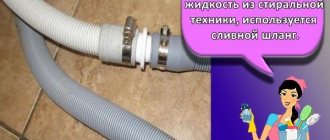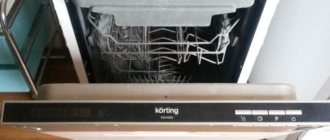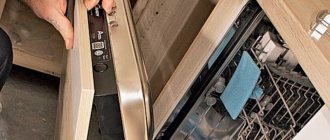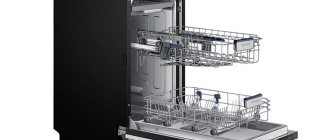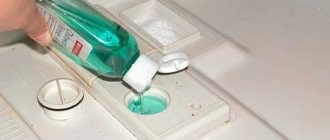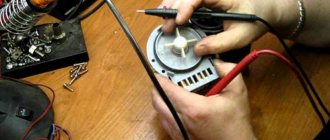A dishwasher is a real salvation for female housewives. After all, thanks to this device, you no longer have to wash the dishes yourself. To do this, just put it in the loading compartment and wait a while. It's simple.
But it is only at first glance that the dishwasher looks like a simple device. A lot of different mechanisms are used inside it to ensure uninterrupted operation for many years. If one of these mechanisms fails, then all operation of the machine stops until the dishwasher is repaired. One such device is a plastic dishwasher inlet hose.
In the operation of a dishwasher, the hose plays the most important role - it supplies cold or hot water inside the loading compartment. If water is not supplied inside, then the dishes are not washed. Therefore, it is very important to diagnose the causes of hose failure in a timely manner, and then eliminate them.
Types of hoses
In addition to the inlet hose, the dishwasher also has a drain hose. It performs the function of draining dirty water after completing the dishwashing cycle. Its safety also plays a very important role, since many factors will depend on this (working speed, presence of unpleasant odor, etc.).
The inlet hose, in particular, has a special design that protects the machine from sudden leaks. This device is called a hose with an “aquastop” device for a dishwasher. It is thanks to such a hose that you can not be afraid of a sudden break in the water supply network. A special mechanism is able to prevent water leakage in the dishwasher in time, after which you can begin to eliminate problems with breakage.
If desired, such a hose can be installed in place of the drain, thereby increasing the safety of the system several times. But before this, it is recommended to install special barrier filters that will prevent the hose from clogging with debris. In addition, it will extend the life of the dishwasher.
Hoses can also be divided by material of manufacture. The most common option is plastic hoses. After all, they are not only practical, but also distinguished by their low cost. This makes it easy to replace the hose whenever necessary.
In addition to plastic, rubber hoses with a metal braid are used. These hoses are distinguished by their durability and ease of installation. They are quite difficult to damage, which gives them some advantage. They are used as fillers.
What is the best way to prepare for such a repair?
First you need to disconnect the unit from the network, sewerage and water supply.
Now our task is to move the machine to a free place, having previously laid cellophane or rags there, which will be necessary to ensure that the remaining water in the device does not spread across the floor. No repair is complete without quality tools; in this case, reliable pliers and screwdrivers will come in handy. It goes without saying that you should already have hoses prepared - the drain and inlet hose for the dishwasher. To choose the correct length, measure the required distance, and remember that these elements should not be installed in tension. Today you can purchase hoses with very different lengths from one and a half to five meters, but products of two to two and a half meters are considered the most optimal. Another important point: any drain or fill hose for a dishwasher must be equipped with a technical passport, which will indicate all its main parameters.
These include permissible water supply pressure, temperature, and so on. Today, such hoses are most often made of PVC with fittings and a plastic cap nut. In addition, modern elements for draining or filling water can be equipped with a special Aqua Stop valve, which prevents leaks. See also -
Error code E24 in a Bosch dishwasher: meaning and solutions
Choosing the Right Hose for Your Dishwasher
In order to decide on the choice of a high-quality dishwasher hose, you need to take into account some points. Such as:
- machine performance characteristics
- hose length
- hose material
- financial budget for the purchase of a hose.
It’s worth starting with the operating characteristics of the dishwasher, since it is necessary to achieve maximum matching of the capabilities of the hose with its operating result. For example, if the machine consumes up to 5 liters per minute, then you can choose a less durable hose. If water consumption is more than 5 liters per minute, then a higher quality hose will be required.
The length of the hose also plays a very important role. If the hose is very short, this can become a very significant obstacle to ensuring the high-quality operation of the device. You shouldn't take a very long one. This will create additional interference when pumping water.
Important! The hose must be selected with some reserve. If the water source is about 1 m long, then it is worth purchasing a hose 1.10 m long.
The material, as mentioned above, also plays a very important role. The main materials are plastic and rubber. Depending on the allocated financial capabilities, it is worth choosing one or another material.
The main problems in the operation of the hose
The most common problem with a hose is its external or internal damage. Over time, any material becomes less resistant to pressure and constant friction of water, thereby causing the hose to fail.
Another reason may be clogging of the internal space. Water in urban water supply conditions often has very low quality indicators. This means that it contains impurities of heavy metals, dirt and other small particles, which over time clog the pipe. In most cases, this has little effect on the operation of the machine, but over time it can cause damage to its internal parts.
Don’t forget about the careless attitude of people during installation. If the inlet hose with aquastop was installed incorrectly during installation, then sooner or later this will affect its operation and error E15 will appear. For example, at the most unfortunate moment, the hose can be knocked out of the fitting, thereby flooding the neighbors below. Don’t forget about this, and it’s better to be on the safe side.
Errors and rules
1Connect the dishwasher in the 220V panel from the machine.
Remember that all equipment and devices in your house and apartment that are interconnected with water and electricity - a boiler, instantaneous water heater, washing machine, including a dishwasher - must be connected through:
- automatic combination + RCD
- or automatic differential
There shouldn’t be any simple modular machines, much less traffic jams, here. Reliability of protection and your safety in the event of an electrical breakdown of the wiring should come first.
2Installation of the dishwasher very close to the wall.
As a result, the supply or drain hoses may become pinched, impairing water circulation. An error will constantly appear on the display.
And you won’t even guess why. Therefore, the minimum distance from the wall should be at least 5cm.
3The machine must be on a level surface.
If the installation is uneven, you will have problems with the quality of washing dishes. There may even be a water leak.
For example, Electrolux models allow a deviation from the horizontal of no more than 2 degrees. This whole thing is checked at the building level.
And it is regulated by twisting and twisting the legs.
The back leg of most models is adjustable from the front. Using a special screw in the lower central part.
When adjusting the legs, according to the instructions, the machine must be raised to the maximum so that there are no gaps left between it and the table top.
4Installation of a 220V socket under the sink.
Although this may seem like the closest and most convenient place to connect the power plug, try to avoid this type of connection.
The slightest blockage and subsequent leakage guarantees a short circuit and fire. For the same reason, it is not recommended to place the extension cord directly behind the dishwasher.
If the factory cord is not enough to reach a stationary outlet, then connect the carrier away from the hoses, at the greatest possible distance.
5 Connection to hot water.
Remember that not every PMM can be connected to a hot water supply system. Be sure to read the instructions, otherwise the device will fail much earlier than its warranty period.
In addition, the water temperature in this system may be higher than that for which the sink is designed (usually no more than 60 degrees). Even if it supports such a connection.
Also keep in mind that the hot water in our pipes is dirtier than cold water. Therefore, experts recommend connecting to cold water. It makes sense to connect to a hot one only if you have your own heating and a gas boiler. Otherwise, it will be a penny saving on electricity, which will ruin an expensive dishwasher.
6 Extending the water supply hose.
It may well happen that the factory hose, which has a standard length of no more than 1.5 meters, is not enough for you. Therefore, you will have to buy more footage.
The most important thing is not to bite off, unscrew or throw away the main one. It can come with leak protection.
Wires are hidden inside it and when a break occurs, a short circuit occurs and the valve installed at the end automatically shuts off the supply.
Therefore, when lengthening, simply extend the existing one.
7 Flax for thread sealing
If you are not a plumber and do not know how to properly and in what quantity flax is wound to seal threaded connections, then it is better for you not to use it.
You may encounter this when reworking the connection of the dishwasher to the siphon and installing a tee for the cold water supply.
If used in excess, the flax will eventually swell and the flimsy union nut may burst, ultimately leading to a flood.
In such places it is better to use a factory rubber gasket or fum tape.
Hose diagnostics
It is very important to thoroughly diagnose the condition of the hose in a timely manner. This should be done at least once a month. It is with this approach that the dishwasher will last a longer period of time.
Diagnostics can be carried out using various devices (like a pressure gauge and the like), but not every city resident has such devices. Therefore, the check should be done using available means.
First, you should assess the condition of the hose visually. If it is in satisfactory condition, then you can check it for leaks. It is better to do this while the machine is running. There are no leaks - the hose is fine.
The presence of blockages can be checked using a plumbing brush or using a regular wire.
Correct hose installation
For high-quality operation of the machine, it is also extremely important to correctly install the drain and inlet hoses. Depending on how the hoses are installed, the further quality of work during operation will depend.
The inlet hose is much easier to install, since it only requires skills in handling simple tools and some time. The essence of its installation is to connect the hose to the water supply and to the inlet valve on the dishwasher. In this case, special attention must be paid to sealing the connection. Thanks to this, leaks will not form.
Replacing the drain hose on a dishwasher is a little more difficult. For a quality installation, you will need to purchase additional items:
- drain siphon (it will prevent odors from entering the apartment);
- fasteners for attaching the hose;
- drain hose at least 1.5 m long.
To make the process of draining water much faster and without causing blockages, it is necessary to place the hose slightly higher than the connection point in the sewer. Usually this is no more than 60 cm. This can be done using special fastening clamps, screwing them to the wall.
Then you need to make a siphon. It is this that will prevent the unpleasant smell from the dishwasher from entering the apartment. The siphon is also easy to install with a small set of tools, after which it should be carefully sealed with silicone sealants. This will also prevent the smell from getting in.
After installing the siphon, you can connect it to the hose and diagnose the operation. If everything is done correctly, the water will drain quickly and without problems.
Types of dishwasher hoses
No matter how strange it may sound, the modern range of dishwashers is more reliably protected from leaks than the same washing machines. As a rule, all dishwashers are equipped with two hoses: drain and fill, and usually the manufacturer gives a good guarantee for these products. In view of this, breakdowns of such accessories are quite rare. However, no one is immune from accidental damage, which may result in a broken hose. Also, many consumers have encountered situations where the dishwasher inlet hose was simply not included in the kit or was too short to properly connect the device.
In any case, you may need a dishwasher drain hose at the most inopportune moment, so you need to clearly understand how to make the right choice and installation.
If you begin to notice that it has become unsafe to use your dishwasher, then replacing the hose is simply necessary. This can be understood by the leaks that will be inevitable in such a situation. Unlike replacing internal parts, changing a hose is not a difficult task, and absolutely anyone can handle it. See also -
How to choose a good washing powder?
Replacing and extending the hose on a dishwasher
Over time, the hose has to be changed. You should not blame the manufacturers, since this process is natural for absolutely all parts of such devices.
To replace the hose, you will need to purchase a new hose of the desired quality and length. It is best to purchase a hose that was previously installed. But you should do this only if you were completely satisfied with the hose’s performance before.
After the hose has been purchased, you just need to put it in its original place. You need to replace all the old rubber bands, treat the mounting area with anti-corrosion repellent, and then check how it works.
Extending the drain hose is also not difficult. To do this, it is necessary to carry out all the necessary measurements of the length to the required object and the diameter of the hose. After that, it is enough to purchase a hose connector of the required length and, with simple manipulations, connect the old hose to the new one.
This way you can grow the hose to very large sizes. The only limitations are the capabilities and needs of a person.
How to extend dishwasher hoses
If there is a need to lengthen the hose due to a change in location of the dishwasher or for another reason, then you need to have an idea of its technical characteristics, calculate the length by which you want to increase the diameter, and purchase a filler or drain hose with the required parameters. To work, you will also need a coupling and three clamps. For reliability, it is better to use a brass coupling rather than a plastic one.
Water supply hose extension
All communications and power to the dishwasher are turned off. The filler hose that comes from the dishwasher is first attached to one side of the coupling, and a hose extension is screwed onto the second side of the coupling, which is connected to the water supply line. It is advisable to change all worn rubber bands, coat the fastening points with an anti-corrosion solution, and check the operation of the hose.
Drain hose extension
There are no difficulties in extending the drain hose on a dishwasher. After preparing it and taking measurements, you need to purchase a sleeve - connector of the required length. Using simple movements, connect the old hose to the new one. By carrying out such manipulations, you can lengthen the drain hose to larger sizes. Mechanics and specialists who repair dishwashers advise not to lengthen the water supply hose, especially in several places, but to change it, since the risk of water leakage is still present.
How to clean a dishwasher hose
During operation, many housewives ask the question: how to clean the drain hose? This will most likely require the help of the male half, since you will have to do a little work with tools.
First, you need to completely disconnect the hose from the machine and the water supply network. After this, you can start cleaning the hose using a special brush or simply soak it in a weak alkali solution (you can also use acids). We clean the inner surface in such a way that there is nothing unnecessary left there. This will allow you to quickly remove absolutely all barriers inside the hose. After the manipulations have been completed, you need to return the hose to its place. If nothing has changed after cleaning, the hose should be replaced.
